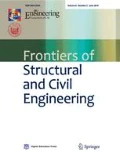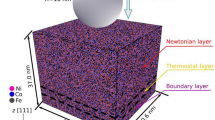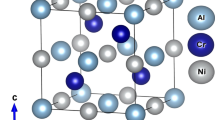Abstract
In this work we conducted classical molecular dynamics (MD) simulation to investigate the mechanical characteristics and failure mechanism of hexagonal boron-nitride (h-BN) nanosheets. Pristine and defective structure of h-BN nanosheets were considered under the uniaxial tensile loadings at various temperatures. The defective structure contains three types of the most common initial defects in engineering materials that are known as cracks, notches (with various length/size), and point vacancy defects (with a wide range of concentration). MD simulation results demonstrate a high load-bearing capacity of extremely defective (amorphized) h-BN nanosheets. Our results also reveal that the tensile strength decline by increasing the defect content and temperature as well. Our MD results provide a comprehensive and useful vision concerning the mechanical properties of h-BN nanosheets with/without defects, which is very critical for the designing of nanodevices exploiting the exceptional physics of h-BN.
Similar content being viewed by others
References
Geim A K, Novoselov K S. The rise of graphene. Nature Materials, 2007, 6(3): 183–191
Novoselov K S, Jiang D, Schedin F, Booth T J, Khotkevich V V, Morozov S V, Geim A K. Two-dimensional atomic crystals. Proceedings of the National Academy of Sciences of the United States of America, 2005, 102(30): 10451–10453
Butler S Z, Hollen S M, Cao L, Cui Y, Gupta J A, Gutiérrez H R, Heinz T F, Hong S S, Huang J, Ismach A F, Johnston-Halperin E, Kuno M, Plashnitsa V V, Robinson R D, Ruoff R S, Salahuddin S, Shan J, Shi L, Spencer M G, Terrones M, Windl W, Goldberger J E. Progress, challenges, and opportunities in two-dimensional materials beyond graphene. ACS Nano, 2013, 7(4): 2898–2926
Radisavljevic B, Radenovic A, Brivio J, Giacometti V, Kis A. Single-layer MoS2 transistors. Nature Nanotechnology, 2011, 6(3): 147–150
Lynch R W, Drickamer H G. Effect of high pressure on the lattice parameters of diamond, graphite, and hexagonal boron nitride. Journal of Chemical Physics, 1966, 44(1): 181–184
Watanabe K, Taniguchi T, Kanda H. Direct-bandgap properties and evidence for ultraviolet lasing of hexagonal boron nitride single crystal. Nature Materials, 2004, 3(6): 404–409
Golberg D, Bando Y, Huang Y, Terao T, Mitome M, Tang C, Zhi C. Boron nitride nanotubes and nanosheets. ACS Nano, 2010, 4(6): 2979–2993
Mortazavi B, Pereira L F C, Jiang J W, Rabczuk T. Modelling heat conduction in polycrystalline hexagonal boron-nitride films. Scientific Reports, 2015, 5(1): 13228
Mortazavi B, Cuniberti G. Mechanical properties of polycrystalline boron-nitride nanosheets. RSC Advances, 2014, 4(37): 19137–19143
Li L H, Cervenka J, Watanabe K, Taniguchi T, Chen Y. Strong oxidation resistance of atomically thin boron nitride nanosheets. ACS Nano, 2014, 8(2): 1457–1462
Zhou H, Zhu J, Liu Z, Yan Z, Fan X, Lin J, Wang G, Yan Q, Yu T, Ajayan P M, Tour J M. High thermal conductivity of suspended few-layer hexagonal boron nitride sheets. Nano Research, 2014, 7(8): 1232–1240
Kumar R, Rajasekaran G, Parashar A. Optimised cut-off function for Tersoff-like potentials for a BN nanosheet: A molecular dynamics study. Nanotechnology, 2016, 27(8): 085706
Wang J, Ma F, Sun M. Graphene, hexagonal boron nitride, and their heterostructures: Properties and applications. RSC Advances, 2017, 7(27): 16801–16822
Yin J, Li J, Hang Y, Yu J, Tai G, Li X, Zhang Z, Guo W. Boron nitride nanostructures: Fabrication, functionalization and applications. Small, 2016, 12(22): 2942–2968
Liu Z, Ma L, Shi G, Zhou W, Gong Y, Lei S, Yang X, Zhang J, Yu J, Hackenberg K P, Babakhani A, Idrobo J C, Vajtai R, Lou J, Ajayan P M. In-plane heterostructures of graphene and hexagonal boron nitride with controlled domain sizes. Nature Nanotechnology, 2013, 8(2): 119–124
Rubio A, Corkill J L, Cohen M L. Theory of graphitic boron nitride nanotubes. Physical Review B: Condensed Matter, 1994, 49(7): 5081–5084
Cresti A, Nemec N, Biel B, Niebler G, Triozon F, Cuniberti G, Roche S. Charge transport in disordered graphene-based low dimensional materials. Nano Research, 2008, 1(5): 361–394
Banhart F, Kotakoski J, Krasheninnikov AV. Structural defects in graphene. ACS Nano, 2011, 5(1): 26–41
Boukhvalov D W, Katsnelson M I. Chemical functionalization of graphene with defects. Nano Letters, 2008, 8(12): 4373–4379
Hashimoto A, Suenaga K, Gloter A, Urita K, Iijima S. Direct evidence for atomic defects in graphene layers. Nature, 2004, 430(7002): 870–873
Meyer J C, Kisielowski C, Erni R, Rossell M D, Crommie M F, Zettl A. Direct imaging of lattice atoms and topological defects in graphene membranes. Nano Letters, 2008, 8(11): 3582–3586
Kotakoski J, Krasheninnikov A V, Nordlund K. Energetics, structure, and long-range interaction of vacancy-type defects in carbon nanotubes: Atomistic simulations. Physical Review B: Condensed Matter and Materials Physics, 2006, 74(24): 245420
Ma J, Alfé D, Michaelides A, Wang E. Stone-Wales defects in graphene and other planar sp2-bonded materials. Physical Review B: Condensed Matter and Materials Physics, 2009, 80(3): 033407
Mortazavi B, Cuniberti G. Atomistic modeling of mechanical properties of polycrystalline graphene. Nanotechnology, 2014, 25(21): 215704
Mortazavi B, Pötschke M, Cuniberti G. Multiscale modeling of thermal conductivity of polycrystalline graphene sheets. Nanoscale, 2014, 6(6): 3344–3352
Lee C, Wei X, Kysar J W, Hone J. Measurement of the elastic properties and intrinsic strength of monolayer graphene. Science, 2008, 321(5887): 385–388
Bourrellier R, Meuret S, Tararan A, Stéphan O, Kociak M, Tizei L H G, Zobelli A. Bright UV Single photon emission at point defects in h-BN. Nano Letters, 2016, 16(7): 4317–4321
Salavati M, Ghasemi H, Rabczuk T. Electromechanical properties of Boron Nitride Nanotube: Atomistic bond potential and equivalent mechanical energy approach. Computational Materials Science, 2018, 149: 460–465
Salavati M, Rabczuk T. Application of highly stretchable and conductive two-dimensional 1T VS2 and VSe2 as anode materials for Li-, Na- and Ca-ion storage. Computational Materials Science, 2019, 160: 360–367
Salavati M. Electronic and mechanical responses of two-dimensional HfS2, HfSe2, ZrS2, and ZrSe2 from first-principles. Frontiers of Structural and Civil Engineering, 2019, 13(2): 486–494
Katzir A, Suss J T, Zunger A, Halperin A. Point defects in hexagonal boron nitride. I. EPR, thermoluminescence, and thermally-stimulated-current measurements. Physical Review B, 1975, 11(6): 2370–2377
Jiménez I, Jankowski A F, Terminello L J, Sutherland D G J, Carlisle J A, Doll G L, Tong W M, Shuh D K, Himpsel F J. Core-level photoabsorption study of defects and metastable bonding configurations in boron nitride. Physical Review B: Condensed Matter, 1997, 55(18): 12025–12037
Hirano S I, Yogo T, Asada S, Naka S. Synthesis of amorphous boron nitride by pressure pyrolysis of borazine. Journal of the American Ceramic Society, 1989, 72(1): 66–70
Taniguchi T, Kimoto K, Tansho M, Horiuchi S, Yamaoka S. Phase transformation of amorphous boron nitride under high pressure. Chemistry of Materials, 2003, 15(14): 2744–2751
Mortazavi B, Ahzi S. Thermal conductivity and tensile response of defective graphene: A molecular dynamics study. Carbon N. Y., 2013, 63: 460–470
Ding N, Chen X, Wu C M L. Mechanical properties and failure behaviors of the interface of hybrid graphene/hexagonal boron nitride sheets. Scientific Reports, 2016, 6(1): 31499
Güryel S, Hajgató B, Dauphin Y, Blairon J M, Edouard Miltner H, De Proft F, Geerlings P, Van Lier G. Effect of structural defects and chemical functionalisation on the intrinsic mechanical properties of graphene. Physical Chemistry Chemical Physics, 2013, 15(2): 659–665
Han T, Luo Y, Wang C. Effects of temperature and strain rate on the mechanical properties of hexagonal boron nitride nanosheets. Journal of Physics D, Applied Physics, 2014, 47(2): 025303
Abadi R, Uma R P, Izadifar M, Rabczuk T. Investigation of crack propagation and existing notch on the mechanical response of polycrystalline hexagonal boron-nitride nanosheets. Computational Materials Science, 2017, 131: 86–99
Plimpton S. Fast parallel algorithms for short-range molecular dynamics. Journal of Computational Physics, 1995, 117(1): 1–19
Matsunaga K, Fisher C, Matsubara H. Tersoff potential parameters for simulating cubic boron carbonitrides. Japanese Journal of Applied Physics, 2000, 39: 48–51
Martyna G J, Klein M L, Tuckerman M. Nosé-Hoover chains: The canonical ensemble via continuous dynamics. The Journal of chemical physics, 1992, 97(4): 2635–3643
Cheng A, Merz K M. Application of the Nosé-Hoover chain algorithm to the study of protein dynamics. Journal of Physical Chemistry, 1996, 100(5): 1927–1937
Nosé S. A unified formulation of the constant temperature molecular dynamics methods. Journal of Chemical Physics, 1984, 81(1): 511–519
Hoover W G. Canonical dynamics: Equilibrium phase-space distributions. Physical Review A, 1985, 31(3): 1695–1697
Mortazavi B, Cuniberti G, Rabczuk T. Mechanical properties and thermal conductivity of graphitic carbon nitride: A molecular dynamics study. Computational Materials Science, 2015, 99: 285–289
Mortazavi B, Makaremi M, Shahrokhi M, Raeisi M, Singh C V, Rabczuk T, Pereira L F C. Borophene hydride: A stiff 2D material with high thermal conductivity and attractive optical and electronic properties. Nanoscale, 2018, 10(8): 3759–3768
Mortazavi B, Makaremi M, Shahrokhi M, Fan Z, Rabczuk T. N-graphdiyne two-dimensional nanomaterials: Semiconductors with low thermal conductivity and high stretchability. Carbon N. Y., 2018, 137: 57–67
Mortazavi B, Madjet M E, Shahrokhi M, Ahzi S, Zhuang X, Rabczuk T. Nanoporous graphene: A 2D semiconductor with anisotropic mechanical, optical and thermal conduction properties. Carbon N. Y., 2019, 147: 377–384
Mortazavi B, Benzerara O, Meyer H, Bardon J, Ahzi S. Combined molecular dynamics-finite element multiscale modeling of thermal conduction in graphene epoxy nanocomposites. Carbon N. Y., 2013, 60: 356–365
Mortazavi B, Rabczuk T. Multiscale modeling of heat conduction in graphene laminates. Carbon N. Y., 2015, 85: 1–7
Mortazavi B, Shahrokhi M, Zhuang X, Rabczuk T. Borongraphdiyne: A superstretchable semiconductor with low thermal conductivity and ultrahigh capacity for Li, Na and Ca ion storage. Journal of Materials Chemistry A, Materials for Energy and Sustainability, 2018, 6(23): 11022–11036
Mortazavi B, Rémond Y, Ahzi S, Toniazzo V. Thickness and chirality effects on tensile behavior of few-layer graphene by molecular dynamics simulations. Computational Materials Science, 2012, 53(1): 298–302
Subramaniyan A K, Sun C T. Continuum interpretation of virial stress in molecular simulations. International Journal of Solids and Structures, 2008, 45(14-15): 4340–4346
Stukowski A. Visualization and analysis of atomistic simulation data with OVITO—The Open Visualization Tool. Modelling and Simulation in Materials Science and Engineering, 2010, 18(1): 015012
Guo H, Zhuang X, Rabczuk T. A deep collocation method for the bending analysis of Kirchhoff plate. Computers, Materials & Continua, 2019, 59(2): 433–456
Anitescu C, Atroshchenko E, Alajlan N, Rabczuk T. Artificial neural network methods for the solution of second order boundary value problems. Computers, Materials & Continua, 2019, 59(1): 345–359
Rabczuk T, Ren H, Zhuang X. A nonlocal operator method for partial differential equations with application to electromagnetic waveguide problem. Computers, Materials & Continua, 2019, 59(1): 31–55
Varshni Y P. Temperature dependence of the elastic constants. Physical Review B, 1970, 2(10): 3952–3958
Ziman J M. Electrons and Phonons: The Theory of Transport Phenomena in Solids. Clarendon Press, 2001
Ziman J M. Electrons and Phonons. Oxford: Oxford University Press, 2001
Liu F, Ming P, Li J. Ab initio calculation of ideal strength and phonon instability of graphene under tension. Physical Review B: Condensed Matter and Materials Physics, 2007, 76(6): 064120
Shirazi A H N. Molecular dynamics investigation of mechanical properties of single-layer phagraphene. Frontiers of Structural and Civil Engineering, 2019, 13(2): 495–503
Shirazi A H N, Abadi R, Izadifar M, Alajlan N, Rabczuk T. Mechanical responses of pristine and defective C3N nanosheets studied by molecular dynamics simulations. Computational Materials Science, 2018, 147: 316–321
Mortazavi B. Ultra high stiffness and thermal conductivity of graphene like C3N. Carbon N. Y., 2017, 118: 25–34
Mortazavi B, Fan Z, Pereira L F C, Harju A, Rabczuk T. Amorphized graphene: A stiff material with low thermal conductivity. Carbon N. Y., 2016, 103: 318–326
Author information
Authors and Affiliations
Corresponding author
Rights and permissions
About this article
Cite this article
Salavati, M., Mojahedin, A. & Shirazi, A.H.N. Mechanical responses of pristine and defective hexagonal boron-nitride nanosheets: A molecular dynamics investigation. Front. Struct. Civ. Eng. 14, 623–631 (2020). https://doi.org/10.1007/s11709-020-0616-5
Received:
Accepted:
Published:
Issue Date:
DOI: https://doi.org/10.1007/s11709-020-0616-5




